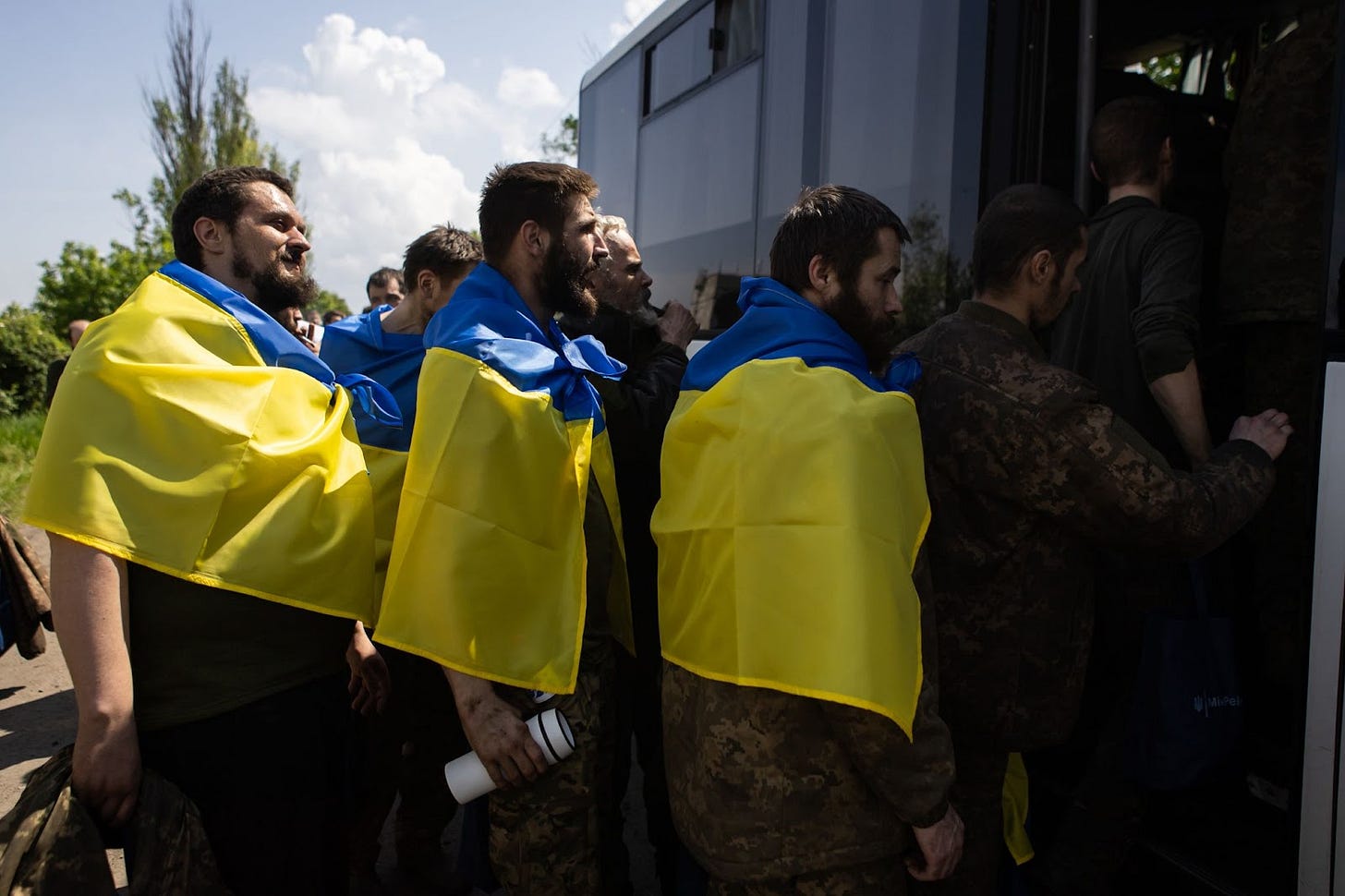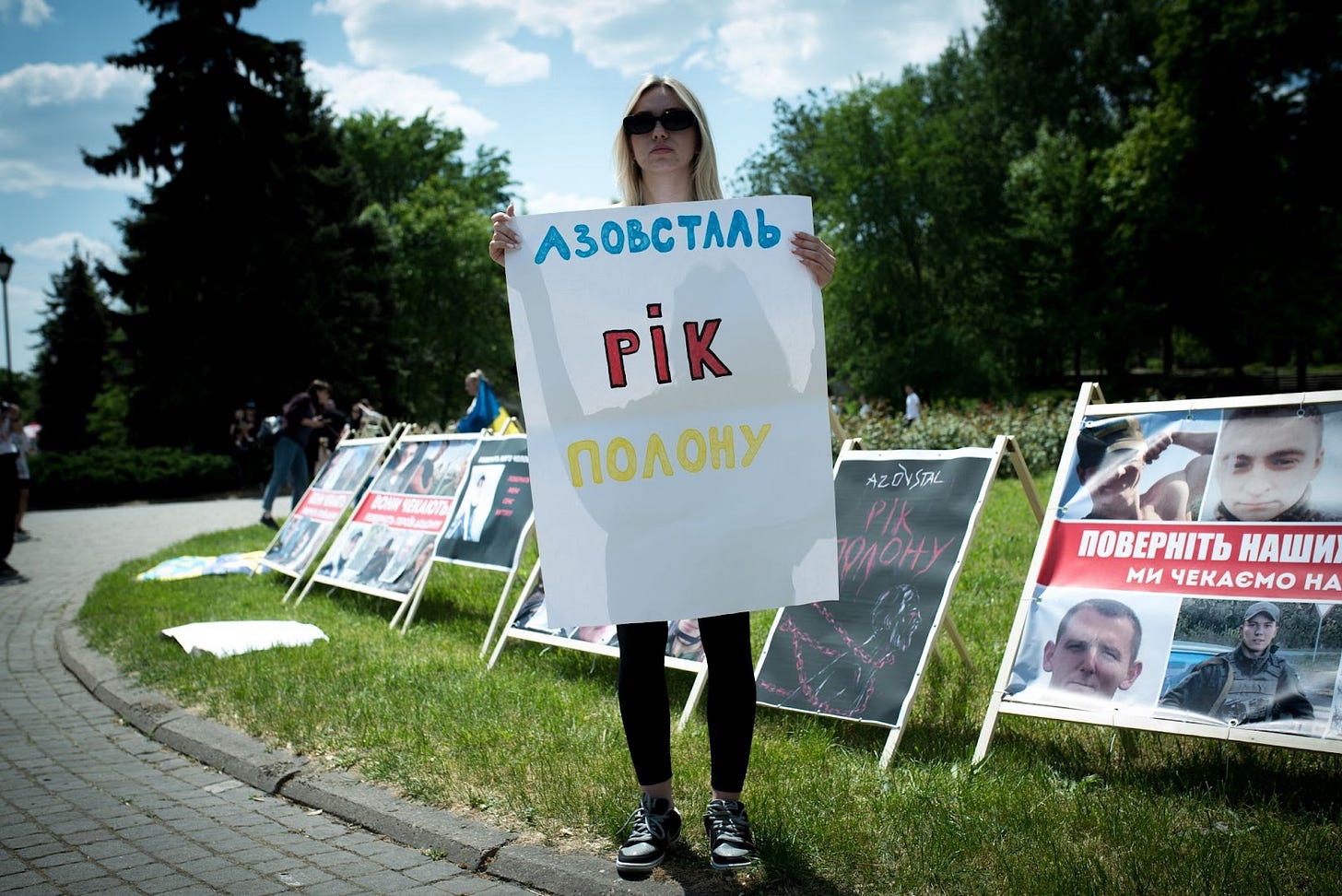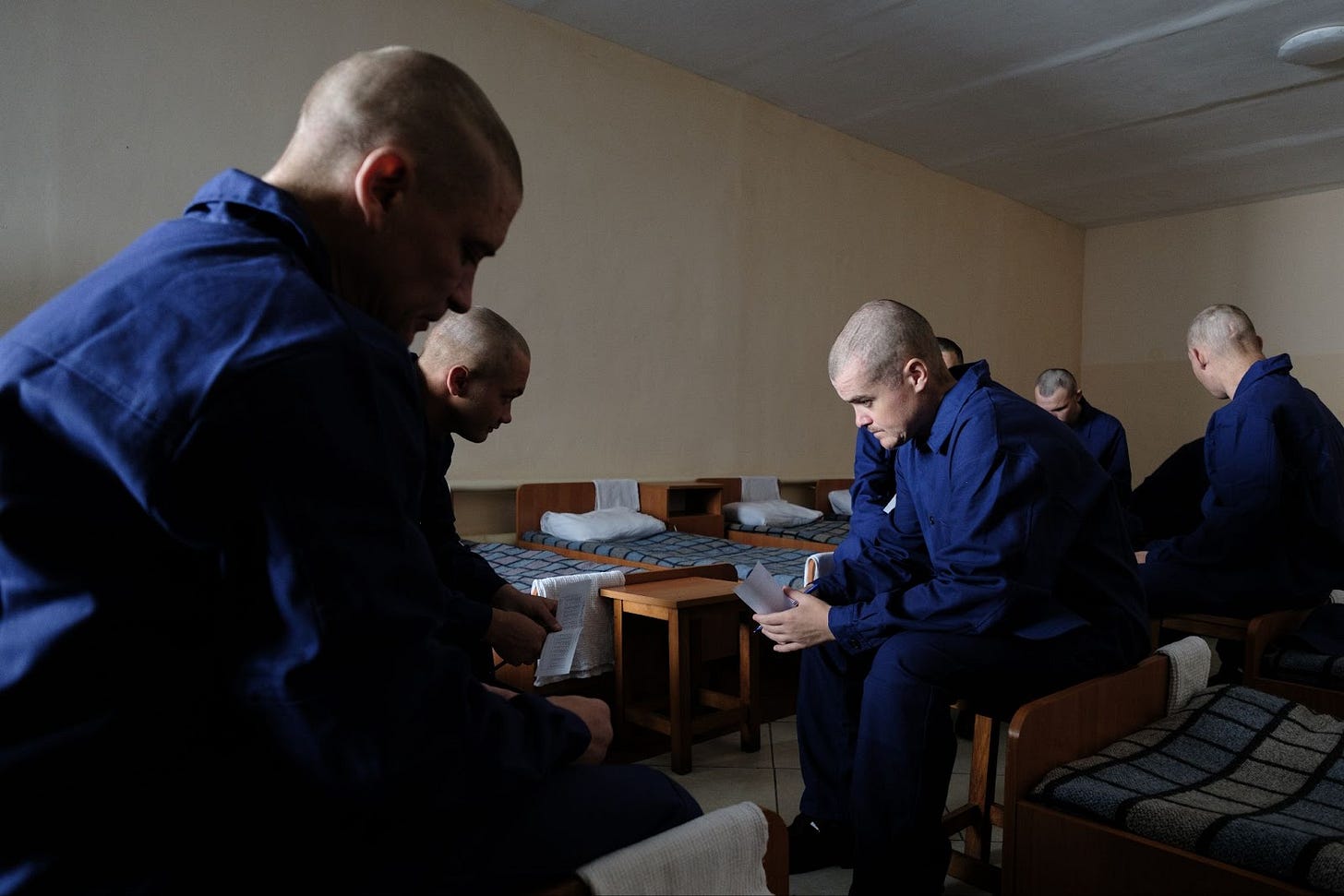Inside Ukraine’s Prisoner of War Negotiations with Russia
Even during war, the two enemies have discussions. On the Ukrainian side, they’re led by the ‘Coordinating Headquarters,’ tasked with talking to Russia. In the news, Russia makes advances in Kharkiv.
Editor’s Note: We continue to be losing paid subscribers at a worrisome pace. If you’re a long-time reader who hasn’t signed up for paid yet, we need your help.
Ukraine is losing ground in the Kharkiv region. News is bleak in the northeast and east. Our work is more important than ever to fight ‘Ukraine fatigue,’ covering a war too many people have forgotten about.
The world of prisoner negotiations is one of the many things obscured by the fog of war.
Even the wives of POWs don’t find out their husbands are being freed until they are on Ukrainian soil.
One woman, whose husband had been taken captive, started to attend these prisoner exchanges, if only in an attempt to get closer to what he must be feeling.
When the prisoners are released, they can be broken.
“There was a Ukrainian soldier who was given a chocolate bar…I watched him unwrap it, hold it to his face, close his eyes and slowly breathe in the smell,” she said quietly, looking down at her feet and shaking her head. “It still gives me goosebumps thinking about it.”
The woman, who asked to remain anonymous due to her husband’s military service, said that as soon as the POWs arrive in Ukraine they are given food – and until they eat you can’t really communicate with them.
At the time, her husband was still in captivity, but after a few months she received a call from the Coordinating Headquarters, the governmental body responsible for issues relating to POWs. She was told that he had been returned.
But not everybody has been so lucky.

After a few days of silence from her husband Serhii, Maria feared the worst.
It was May 2022 and he was a soldier in Mariupol defending Azovstal, which had been under siege for the last two months.
But then, finally, she saw a video of Serhii alive. The Ukrainian defenders had surrendered and he had been taken as a Prisoner of War by Russian forces.
Maria’s husband is one of the 900 Azov fighters still held in captivity in Russia.
“It has been more than a year and I still don’t know anything about him or his whereabouts,” she said.
With the full-scale invasion in its third year, relations between Russia and Ukraine have been completely destroyed. The rupture goes beyond diplomatic or political relations, and shows up everywhere – Ukrainian Olympians are instructed not to interact with their Russian counterparts; Ukrainian authors refuse to accept awards alongside Russians.
Possibly the only cooperation remaining between the two countries is done by a special group located within the Coordinating Headquarters. They are tasked with negotiating prisoner exchanges.
Maria, like other relatives of POWs in Russian captivity, has no idea when or if ever her husband will be returned. The inner workings of the negotiations with Russia over prisoner swaps are almost impossible to understand or predict – even to the negotiators.
“Their [the Russian] policy is not to support us, not to give us any clear information,” says Petro Yatsenko, the spokesperson for the Coordinating Headquarters.
The Counteroffensive spoke to Konstantinas Rimsa, who specializes in hostage negotiations and was involved in training Ukrainian POW negotiators from 2014 to 2022.
Konstantinas explains Russia is very ready to delay and obstruct the POWs negotiations.
“They [Russia] know Ukraine has a manpower shortage,” he explains. “And a good percentage of POWs will go back into the fight in Ukraine.”
Russia also knows that holding onto these soldiers causes problems for Zelenskyy at home. Petro explains that Russia has been known to tell relatives of captives that if they go out and protest, their loved ones will be returned – an attempt to spark division.

So when the negotiators are finally sat across from each other, it’s crucial for them to play their cards right.
Konstantinas explains that when the negotiators sit down they have to be prepared.
They will have their opening lines ready, a list of what they are ready to negotiate and what they are not, and a list of what they could negotiate under certain circumstances.
It’s also vital that you do not lie.
“You have to come across as reliable as possible… If you do lie, you have to write it down and keep it as a reminder,” Konstantinas emphasizes.
But just as important as how you prepare for the negotiations is the character of the person taking part, Konstantinas explains.
“You have to have a healthy mind, otherwise you won’t be able to do the job… you can only teach relaxation exercises and breathing exercises. But small psychological techniques won't work if you pick the wrong person,” he explains. When the negotiations can go on for up to ten hours, stamina and mental fortitude are key, you need somebody who can talk a lot, Konstantinas explains.

However, even with the right person the psychological strain of negotiations is a lot to bear, so there will be a psychologist outside of the room to make sure the negotiator stays calm but also so they can do a character profile of the negotiator on the other side.
Konstantinas explains that the psychologist will use a technique that can be remembered using the acronym MICE — money, ideology, compromise, ego — to create a character analysis of the negotiator on the other side to figure out how to apply pressure.
Although these tactics are more commonly used with hostage negotiations rather than POW negotiations, “there will always be certain psychological things to consider, why do they want a certain prisoner? Or the psychological pressure which is the delay,” Konstantinas explains.
But it is almost impossible to find any pattern to understand which soldiers the Russians want to exchange, Petro explains.
“Every prisoner swap formula is unique… it's a very difficult, long term process,” he adds.
Petro gives an example of a time when the negotiating team agreed with Russia to exchange 10 heavily injured POWs, many of whom had costly medical needs, and would logistically be beneficial for the Russians to return. However, Russia returned 5 injured and 5 non-injured soldiers. “We have no idea why,” Petro said, shaking his head.
MICE is part of a science called neuro-linguistic programming, a larger science which looks at how language and psychology can influence our behavior and is part of Konstantinas’ training curriculum. Konstantinas explains some of the tactics used in hostage negotiations that come from the study of neuro-linguistic programming:
“You go in for a negotiation and the other side sends in somebody that looks almost identical to you but just happens to be twice your size. That is neuro-linguistic programming.”
Konstantinas explains that the different categories of those held captive is also something which influences and complicates the exchanges. Many of the captives are civilians, mostly people that got caught in filtration camps in occupied territory.
However, if Ukraine sets a precedent for exchanging Russian soldiers for civilians, Russia has an incentive to capture more civilians which they can easily do in occupied territory.
Petro explains that a third of those in captivity are civilians, including three military orchestras, some unclear number of doctors and even religious chaplains.
Since the beginning of the full-scale invasion there have been 51 prisoner swaps, which have led to a total of 3,135 POWs returned to Ukraine, Petro says.
With relations between Russia and Ukraine at an all time low, third party countries have come to play an important role in the negotiations.
Turkey and Saudi Arabia worked together to negotiate what was then Ukraine’s largest ever prisoner exchange. At the end of the first year of the war, Russia released 215 captives, a mixture of Ukrainians and foreign citizens, some of whom had previously been sentenced to death while in captivity. In return, they received 55 Russian prisoners and Victor Medvedchuk, a pro-Russian Ukrainian politician.
Although that exchange was a huge success considering the amount of people that were returned, not all foreign involvement has had positive results.
Last year Hungary received 11 Ukrainian POWs that had been held by Russia. Ukraine was quick to announce that they had not been notified of the exchange, a violation of the Geneva convention. When Patriarch Kirill, the head of the Moscow Orthodox Church, announced that the Ukrainians that had been returned had Hungarian roots, some felt it was an extension of Hungary’s attempts to sow division amongst Ukrainians.
However, two of the men exchanged later told the German newspaper Deutsche Welle that they had no Hungarian roots, but had been instructed to say so by the Russian government. They also claimed that only one of their 11 fellow captives actually had Hungarian roots. The two men were also reportedly warned that if they returned to Ukraine before the end of the war, they could jeopardize future exchanges of this kind.
With each negotiation being totally different and the result of a unique set of factors, Maria watches these confusing POW exchanges carefully, hoping that one day her husband Serhii will be freed too.
After the paywall: Russia makes gains, pushing deeper into the Kharkiv region and capturing a Ukrainian settlement.
And Alessandra, who has been driven extensively throughout that region, explains how her driving has gotten worse since driving in Ukraine.
Keep reading with a 7-day free trial
Subscribe to The Counteroffensive with Tim Mak to keep reading this post and get 7 days of free access to the full post archives.




